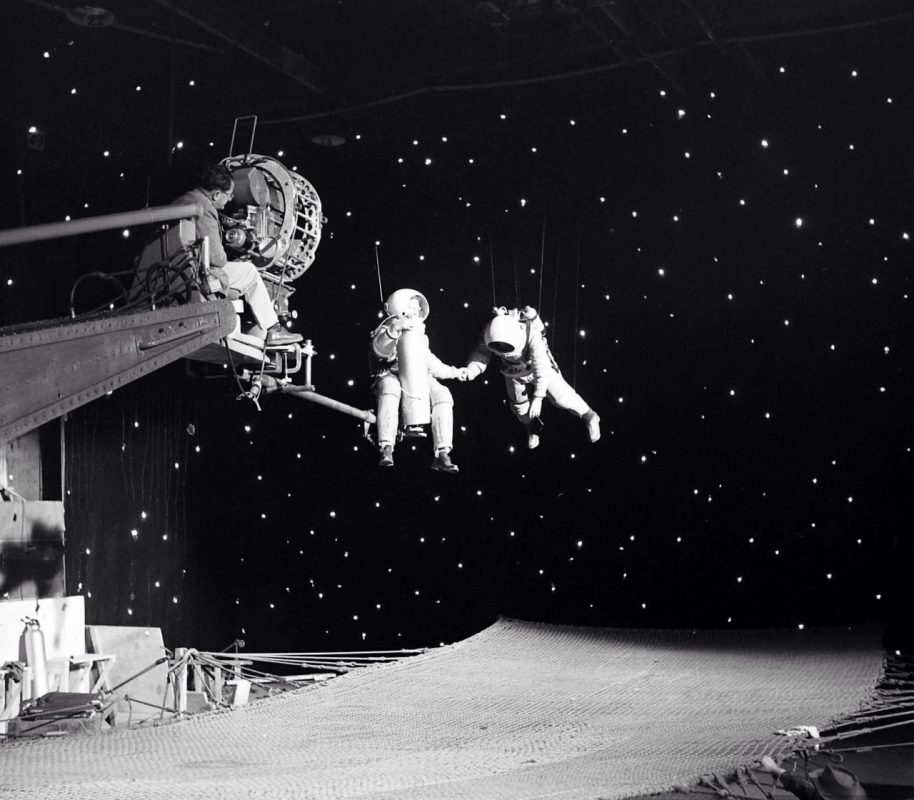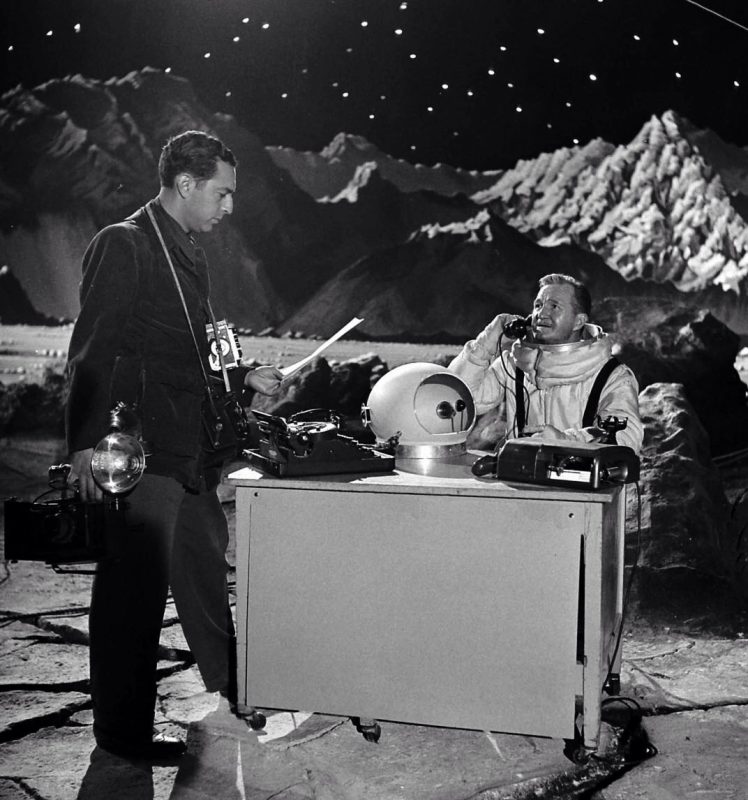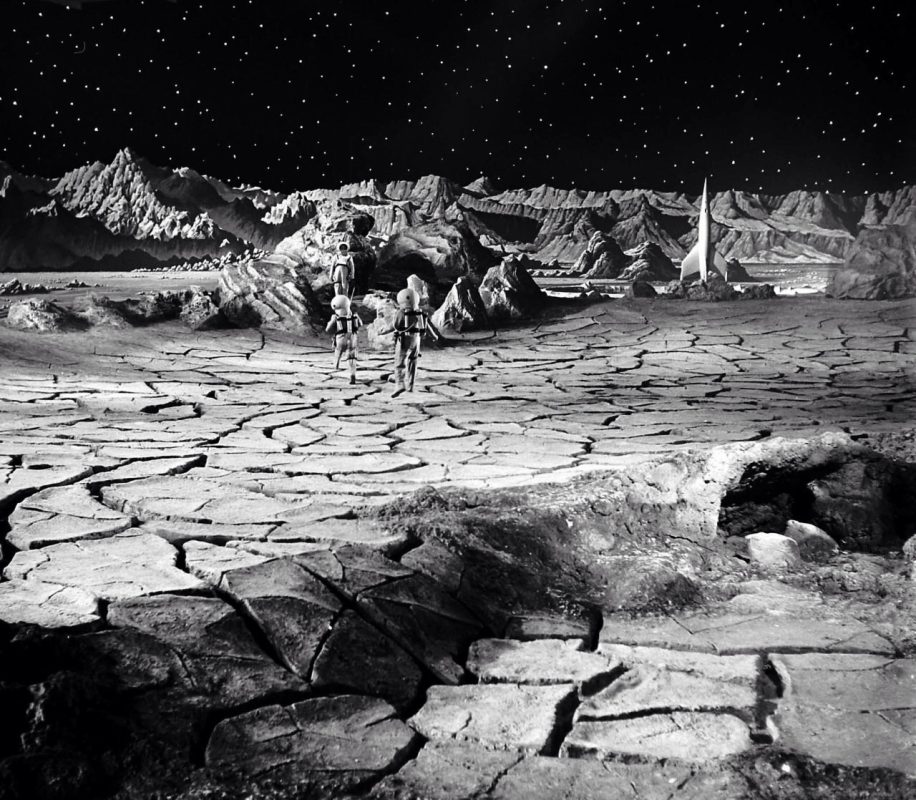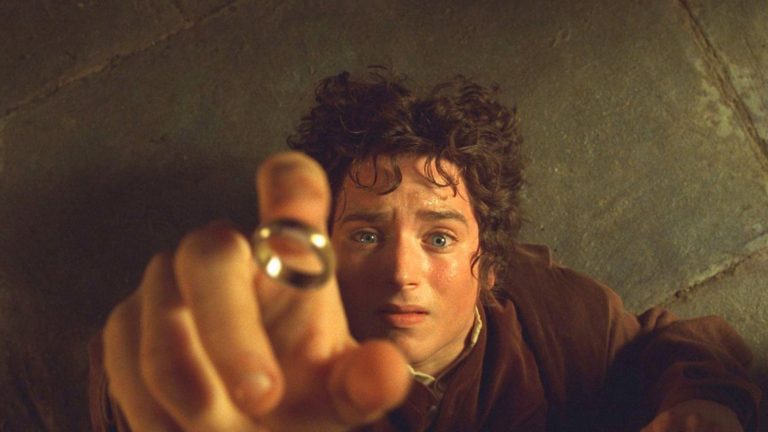Destination Moon – The 1950 science fiction classic is pioneering in more ways than just one.
On June 29th,1950, the science fiction film finally came into its own as a commercially viable genre. Produced by George Pal and directed by Irving Pichel from a screen story by the great Robert A. Heinlein, who also co-wrote the screenplay with Rip von Ronkel, “Destination Moon” (1950) was the first major American science fiction film of the postwar era. Up until that point, the science fiction genre in American cinema, especially the spacefaring kind, was largely confined to serials instead of features, and certainly wasn’t considered a mature genre worthy of adult attention. There had been a few German films in the Twenties and Thirties that tried to realistically depict space travel, most notably Fritz Lang’s “The Woman in the Moon” (1929), but for obvious reasons most of them were never released outside of Europe and no one wanted to screen them for many years afterwards.
When “Destination Moon” was first released, however, it arrived at the perfect time to capture the audience’s imagination. The atomic bomb had a profound effect on the American public’s perception of science fiction; it was no longer merely pulp entertainment, but a genre that spoke to the new realities of the era, both the brand-new fears and hopes alike. There was a sudden boom in science fiction paperbacks, coinciding with the emergence of two highly-regarded magazines, “Galaxy” and “The Magazine of Fantasy and Science Fiction,” that emphasized social commentary and literary quality. Suddenly, the genre had mainstream respect and was attracting the attention of leading writers and critics alike, who finally started taking it seriously.
Few writers benefited more from this newfound respect than Heinlein. He had already made a name for himself as the finest writer at “Astounding Science Fiction,” which for many years had a near-monopoly on the adult science fiction market, and when he became the first to break into the “slicks” after the war when he published stories in “The Saturday Evening Post,” he secured himself a reputation as the genre’s finest writer among the general public as well. Clearly, he was the ideal person then to help the genre break into the cinematic mainstream as well.
Although “Destination Moon” is often regarded as the movie that instigated the SF movie boom of the 1950s, the full degree of its influence is still debatable. The following year saw the release of two even more classic films, “The Day the Earth Stood Still” and “The Thing From Another World,” both of which would prove to be even more influential on not just that decade’s genre output, but on all other science fiction films since.
As Bill Warren noted in his outstanding book on 50s science fiction movies, “Keep Watching the Skies!” it’s very easy to overrate or underrate the film, both in terms of quality and importance. The presence of Heinlein’s name on the script means that many SF fans will overrate it, and still others will underrate it, given his polarizing nature among the science fiction community. Additionally, the pro-capitalist message of the film means that many of those on the left will unfairly excoriate it, while an equal number of those on the right will overpraise it.
Sensible viewers across the political spectrum, however, will try to evaluate it fairly based on whether it succeeds as a movie and how successfully it conveys its message. When you try to look at it with as unbiased an eye as possible, “Destination Moon” is still a good film, not a great one, but still consistently intelligent and interesting in its ideas, even if it doesn’t quite manage to maintain that consistency in its execution.
With a single exception, the acting is fine, and any shortcomings in the performances are rooted more in the lack of adequate characterization in the script. The film’s greatest flaw is that it suffers from a very obvious three-act play structure, and each act is progressively weaker and less interesting than the one before it. Ironically, the Earthbound first act is the most interesting as a reflection of Heinlein’s own political thought, and that’s what we’ll concentrate on here.
The film opens with the disastrous testing of a government rocket. Scientist Charles Cargraves (Warner Anderson) suspects sabotage, given that four years of research and evaluation meant that the test should have been flawless, but as General Thayer (Tom Powers), who initiated and guided the project, solemnly tells him, they won’t have a chance to find out. “Things like this mean military cuts, boy. Research is going back to the laboratories.” Nonplused, Cargraves simply replies that he is headed back there as well.
We then cut to airline industrialist Jim Barnes (John Archer) returning to his civilian job at his self-owned aircraft company. When General Thayer drops in for a visit, he wastes no time getting to the point: It is absolutely essential that the United States not just get to space first, but be the first to land on the Moon, whether it be by atomic or chemical-fueled rockets.
At first, Barnes displays the expected skepticism, but he suddenly shows interest when Thayer describes the new atomic engine Cargraves has been working on. When he asks why the government hasn’t shown the same curiosity, Thayer gives him a straight answer, and it is here that the main political message of the film is most forcefully expressed: “It’s peacetime, Jim. The government isn’t making that kind of appropriation. When it needs the rocket one of these days, and it’s not ready, then the government will do the job. And they’ll turn to you, to private industry, to do it!”
The main problem, as Thayer sees it, isn’t the lack of money, but the lack of initiative, a need to pool both research and resources to meet the challenge. “But combined American industry, sparked by Jim Barnes,” he says, “could put America on the Moon within a year!” A successful pitch is made at a gathering of potential financial backers, with the aid of a Woody Woodpecker cartoon explaining the physics of rocketry (which clearly influenced David Koepp and Steven Spielberg when they used a Mr. DNA cartoon to explain the genetic engineering of “Jurassic Park”). Once Thayer establishes that the first nation to make a foothold on the Moon will be the first to be able to use it for military purposes, all arguments are settled, and the attending parties agree to finance the construction of the ship and the planned expedition.
The ensuing montage of research and manufacturing, leading to the construction of the completed rocket, is halted when a fly lands in the ointment: the government announces it is blocking the scheduled rocket launch on grounds of safety concerns. They sneak by this simply by advancing the rocket launch ahead of schedule. When their radio operator is felled by a bout of appendicitis, mechanic Sweeney (Dick Wesson), who has already been trained in the use of the equipment, is hurriedly assigned as his replacement. Even after the launch, not all goes smoothly, as mishaps both during the voyage and after the landing threaten both the success of the mission and the lives of the crew.
Even though the first act of the film is relatively brief, it’s also the most interesting, and it’s also the section that’s the most decidedly Heinleinesque, featuring dialogue and themes redolent of Heinlein’s previous stories. It’s fascinating to watch the interactions between scientist-engineer Cargraves, industrialist-entrepreneur Barnes and military veteran Thayer, who together represent the classical Heinlein Trivium of Science and Technology, Business and Industry and The Armed Forces, whose collaborative efforts are not only necessary for a Moon mission, but for the survival of civilization (a similar message is found in “The Thing from Another World” where science and the military must overcome their differences and work together to defeat a deadly space alien).
Recommended For You: 30 Underrated Sci-Fi Movies From Across The Globe
“Destination Moon” is remarkable for its optimistic, even triumphalist view of the American Way of science and industry at a time when the national mood was still shaken by the Atomic Bomb and leaned towards pessimism. Government is viewed not as a collaborator in “Destination Moon” but as a roadblock to technological and entrepreneurial progress; the best thing it can do to help the Space Race is get out of the way and let the Big Brains and Hard Workers do what they must to get the job done.
Nor can “The People” be trusted, as shown when protests over the alleged safety of the rockets threaten their first flight; one is reminded of similar protests over the Cassini-Huygens space probe, which tried to halt an invaluable scientific research project but fortunately failed. Although a collaborative effort, the success of the Moon project is shown to ultimately depend on the individual initiative and efforts of its members, and rigid collectivism is depicted as a roadblock to progress.
Additionally, “Destination Moon” takes the Jeffersonian or Whig stance of viewing the free market and other American institutions as intimately bound to science and technology. Ten years before Dwight Eisenhower’s address warning of the supposed “military-industrial-science complex,” “Destination Moon” postulates such a convergence as a not-entirely undesirable outcome of socio-economic evolution. As Barnes tells the gathered businessmen, “To stay in business, we have to build this ship.” His words are certain to send shivers down the spines of both advocates of an entrepreneurial approach to space exploration and those lamenting the intrusion of the free market into the same, for completely different reasons. While such a pro-market stance is unsurprising from Heinlein at this stage of his career, it’s quite strange to find them in a film directed by Pichel, a lifelong democratic socialist who had been one of the earliest victims of the blacklist.
Perhaps the differences in political philosophy between the writer and director help account for the fact that the film gives contrary opinions a fair hearing throughout, something that Heinlein was known to do throughout his stories. When someone interrupts to ask why the government doesn’t take charge of such an important and expensive project, he explains: “The vast amount of brains, talent, skills, and research facilities necessary for this project are not found in the government. Nor can they be mobilized by the government in peacetime without fatal delay. Only American industry can do this job, and American industry must get to work now, like it did in the last War.”
When someone points out that government footed the bill for World War II (part of Heinlein’s genius as a writer lay not only in providing space to opposing views, but in demonstrating that they could be equally sensible), Barnes replies “And they’ll foot this bill too, if we’re successful!” The argument it makes for the free market taking initiative in space exploration seems to reverberate even stronger in this era of SpaceX and Blue Origin, and we see the same debates over public versus private funding of spaceflight continuing to unfold today.

Even if one wishes the three primary characters in “Destination Moon” were better developed, they still have distinct and recognizable personalities that make them appealingly human; this is another characteristic of Heinlein’s writing that likely managed to survive the studio’s subsequent revisions. Unfortunately, we have that fourth character to worry about, and it is here that the rockets start to sputter. Seemingly intended as an everyman persona for whom audiences would supposedly identify with as a surrogate whenever the need for technical explanation arose, the cliched character of Sweeney instead winds up being abrasive, even insulting at times. Depicted as a stereotypical blue-collar Brooklynite obsessed with beer, baseball and hot dogs, Sweeney is played by Dick Wesson, who hailed from Boston and sounds like it. I suspect most New Yorkers will find this character as endearing as most Southerners find their similarly condescending depictions throughout much of the media.
The other three actors, John Archer (father of actress Amy Archer), Tom Powers (forever immortalized as Barbara Stanwyck’s ill-fated husband in “Double Indemnity”) and Warner Anderson, all fare much better in their parts, especially considering the uncomfortable conditions under which they labored (detailed by Heinlein himself in his article “Shooting Destination Moon”). Of course, they have the advantage of also having more likeable and interesting characters, and despite the criticism levied against the film for their lack of dimension, there’s more depth to them than one might realize.
It is clear at the gathering of investors, for instance, that Barnes has more scientifically pure motivations for embarking on this venture than providing another notch on his financial portfolio. “I want to do this because it’s never been done. It’s research. It’s pioneering! What’s the Moon, another North Pole?” One wonders if he was Richard Branson or Elon Musk’s hero while they were growing up. Cargraves was at the time one of the most realistic scientist characters on the screen outside of biopics; he’s a family man at heart who has the most reluctance to go up on this mission, because it means leaving behind his wife (fifth-billed Erin O’Connor, who has about two minutes of screen time) and kids who he barely gets to see enough of as is.
Most fascinating of all is General Thayer, the Prime Mover behind the Moon project. He’s the most clearly Heinlenesque of all the characters in the film, the archetypical “Old Man” who encourages competent individuals to apply their intellectual talents to tasks and achievements which will have long-lasting social good, and who turns up as a motif throughout Heinlein’s stories. He’s very much like D.D. Harriman, the hero of “The Man Who Sold the Moon” (which resembles “Destination Moon” much more than its ostensible source novel, “Rocket Ship Galileo”) and “Requiem,” and his poetic musings are reminiscent of Rhysling, the spacefaring bard of “The Green Hills of Earth.”
You Might Like: Think You Know Alien? These Mindblowing Facts Will Make You Think Again!
It’s easy to understand why Cargraves and Barnes insist that he be one of those allowed to return to Earth even though he reasonably insists that as the oldest he should be left behind: it was his soaring rhetoric that convinced them to go to the Moon in the first place and will convince others to return. Powers gives by far the best performance in the film; his commanding delivery ensures that his character comes off as inspiring and reasonable instead of strident or overbearing.
Once we get to the Moon itself, we start to see where the contributions of Heinlein ended and those of other writers began. It’s not that the subsequent two acts are badly written in any way, but they’re far less interesting than the provocative discussions of the first act. The astronauts actually do very little of dramatic interest during their trip, other than the soon-to-be cliched scene of a mid-flight crisis where one character starts to drift away helplessly while trying to repair a carelessly-greased radio antenna (it’s not surprising to find out this was one of the movies Arthur C. Clarke screened for Stanley Kubrick while they were writing “2001: A Space Odyssey”). They do even less once they reach the moon, besides the overlong climax where they find they don’t have enough fuel left and must lighten the load if they are to ever get home.

Visually, however, the space scenes remain striking and memorable. Although the sets and backdrops are primitive by today’s standards, Chesley Bonestall’s matte paintings have lost none of their beauty, and the Moon landing itself is hauntingly photographed by Lionel Lindon. The film is also graced by a marvelous score courtesy of Leith Stevens, which splendidly conveys the emotional thrill of voyaging to parts unknown. Pal would make up for the lack of garish spectacle in this film with his subsequent films, “When Worlds Collide” and “War of the Worlds,” and continue over the next two decades to produce some of the most memorable American science fiction and fantasy films
Ironically, Destination Moon’s most notable cinematic descendants aren’t science fiction at all. Both Philip Kaufman’s “The Right Stuff” (1983) and Ron Howard’s “Apollo 13” (1995) may be based on real-life events, but they owe as much if not more to “Destination Moon” as any science fiction film that has followed in its wake. “The Right Stuff,” needless to say, does a far better job of depicting the real-life drama and politics of the actual Space Program, exploring it in as much depth as possible, and also features a much more compelling dramatis personae, superbly acted by all involved. Of course, Kaufman had the advantage of being able to depict the actual people and historical events documented in Tom Wolfe’s book, while Pal, Pichel, and Heinlein had to rely on their imagination in depicting how such a program may conceivably happen.
In “Apollo 13,” which starred real-life Heinlein fan Tom Hanks, much of the suspense comes not from the question of “will they make it home?”-we already know that answer-but watching the intellectual drama of technical problem-solving unfold during a highly tense, life-threatening situation with the entire world watching. A similar drama takes place in “Destination Moon”; in both films, some of the most thrilling moments come out of the most unlikely of situations, scenes of characters whittling out math problems with the use of side rules and comparing their results. The crises in both films are similarly solved through rationality, courage, and resourcefulness, and these are depicted as not just human virtues but American values, ones which Heinlein extolled throughout his work.
In recent years, the advances in special effects, as well as filmmakers taking the advice of technical advisors (somewhat) more seriously, have resulted in a minor return to the hard-science approach “Destination Moon” took to space travel. Both “Gravity” and “The Martian” are very much in the spirit of Pal’s production, attempting to be as scientifically accurate as possible in not just their depiction of spaceflight, but of the sort of emergencies and crises that spacefarers might actually encounter “out there,” and more importantly, the solutions they will need to come up with to work their way out of them.
Even “Europa Report,” despite its fanciful depiction of life on Jupiter’s smallest moon, is in the “Destination Moon” tradition with its semi-documentary approach. Yet it’s Christopher Nolan’s “Interstellar” that thematically most resembles it: both films not only extoll the human urge to explore further, but attack social assumptions hindering such a drive to discovery, and strongly suggest that we will need to travel further not just to satiate scientific curiosity but to ensure our survival as a species.
For the most part, scholarly analysis of “Destination Moon” has, like much writing on science fiction cinema of the 1950s, focused on the Cold War background of the film. Now, seventy-five years after its release, it’s time for a reassessment of the film’s often-overlooked virtues. In spite of numerous flaws, the film is intelligent enough and assertive enough in conveying its message to merit serious attention from thoughtful audience members, and may also serve as a useful starting point for discussion on the roles both government and private enterprise have to play in the next step in the Space Age.








![The Remains of the Day [1993] and The Price of Conscientiousness](https://79468c92.delivery.rocketcdn.me/wp-content/uploads/2022/01/TROTD_3-768x324.jpg)
